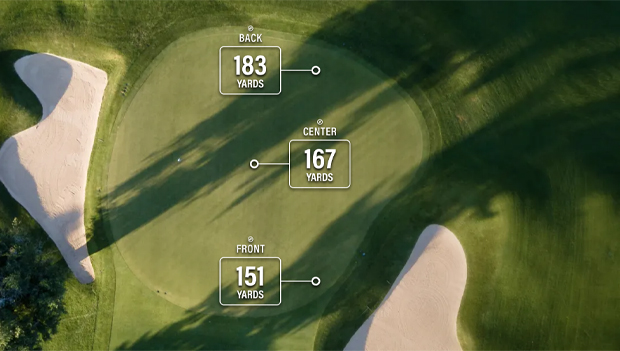
Bushnell is a name synonymous with golf rangefinders, devices that provide critical information to golfers. A great rangefinder calculates distance to the flag or other targets with pinpoint accuracy, becoming a reliable tool that golfers simply can't go without. The best Bushnell rangefinder gives a golfer trustworthy information in the most appropriate medium for the player. Sometimes that could be a traditional rangefinder used to laser distances or it could also come in the form of a GPS watch or speaker. Regardless of the medium, these rangefinders take the uncertainty away from a golfer by showing exactly how far away the target is on any given shot. In a game as difficult as golf, indecisiveness is the last thing anyone needs.
Rangefinders rank among the best golf gifts because of their longevity and effectiveness. A pair of comfortable golf shoes may only last one season, but a Bushnell rangefinder is a long-term investment that changes how you think about the game. The ACTIVE editorial team has taken a look at the best types of Bushnell rangefinders to help you sort through the ones that will suit your game best.
Why Trust Us?
ACTIVE.com's editorial team relies on the knowledge and experience of fitness and wellness experts including competitive athletes, coaches, physical therapists, nutritionists, and certified trainers. This helps us ensure the products we feature are of the highest standard. Collectively, the team has spent countless hours researching equipment, gear, and recovery tools in order to create the most accurate, authentic content for our readers. Customer satisfaction is also a key part of our review process, which is why we only feature products that are highly rated.
The Best Bushnell Rangefinders - Our Top Picks
By clicking on the product links in this article, we may receive a commission fee at no cost to you, the reader. Sponsorships and affiliate commissions help support our research so we can help you find the best products. Read our full affiliate disclosure here.
- Most Popular Bushnell Rangefinder: Bushnell Pro XE
- Most Compact Bushnell Rangefinder: Tour V5 Shift
- Best Range Bushnell Rangefinder: Tour V5
- Best Performance Bushnell GPS: Phantom 2 GPS
- Best Bushnell GPS Watch: ION Edge
- Best Bushnell GPS Speaker: Wingman
Most Popular Bushnell Rangefinder - Bushnell Pro XE
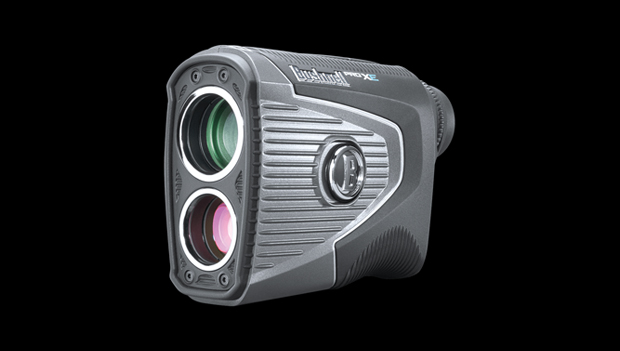
SPECS
- Accuracy: Within 1 yard, range of 5-1,300 yards
- Slope: Yes
- Optics: 7x magnification
- Scan speed: Laser
- Battery life: One CR2 battery, replaced every few months
The Pro XE is Bushnell's most powerful, accurate, and consistent rangefinder. It's accurate within one yard and has a range of 5-1,300 yards, so there is no doubt when it comes to getting the exact distance. Perhaps more impressive than anything else, the Pro XE is reliably accurate with compensated distance, as well. This means that it can account for slope, temperature, and barometric pressure to come up with the "real" yardage you need to play. There is a slope button that turns this function on and off, which is handy for competitive players. The clarity of the 7x magnification is another separating factor, as there is no issue identifying and measuring targets in the distance.
Some of the smallest details are appreciated by users. One that we love is that a magnet has been built into the Pro XE so it can easily attach to your clubs, sitting on top of your bag while hitting a shot. It also easily attaches onto the cart. Being caught in bad weather is also no sweat given the IPX7 fully waterproof rating.
What We Like
- Precise compensated distances
- Built-in magnet can attach to clubs
- 7x magnification for increased clarity
- Industry-leading accuracy
- Fully waterproof
What We Don't Like
- More expensive than other rangefinders
- No Bluetooth capabilities
Most Compact Bushnell Rangefinder - Tour V5 Shift

SPECS
- Accuracy: Within 1 yard, range of 5-1,300 yards
- Slope: Yes
- Optics: 6x magnification
- Scan speed: Laser
- Battery life: One CR2 battery, replaced every few months
There are a few key differences between the Pro XE and the Tour V5 Shift. While both share the same level of accuracy, the Tour V5 Shift only measures elevation change for its compensated yardage, and it is also not waterproof. The magnification is a little worse than the Pro XE and it is slightly smaller, but the display screen on the Tour V5 Shift is top of its class.
Other than those variables, there is not much separating the two rangefinders. The Tour V5 Shift is considerably cheaper and offers a similar level of accuracy, so if you are not bothered by losing some of the added features of the Pro XE, then this could be the right device for you.
What We Like
- Sharp clarity in LCD screen
- Magnetic cart mount
- Pinseeker with visual jolt
- Can connect to Bushnell app for hole overviews
- Easy to adjust settings
What We Don't Like
- Not waterproof
- Only measures elevation for slope
Best Range Bushnell Rangefinder - Tour V5
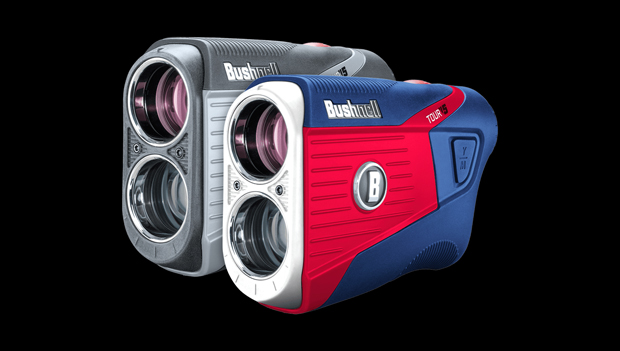
SPECS
- Accuracy: Within 1 yard, range of 5-1,300 yards
- Slope: No
- Optics: 6x magnification
- Scan speed: Laser
- Battery life: One CR2 battery, replaced every few months
The Tour V5 is the next laser rangefinder in the Bushnell family, and this one comes at a lower price point than the Tour V5 Shift. The major difference is that the Tour V5 does not have a slope function, so it only offers accurate measurements to the flagstick and other targets without any compensated distance. This will be a deal-breaker for some who swear by the slope setting, but a lot of players may not use the setting.
Other than that prominent difference, these two rangefinders are essentially identical. If you are just looking for accurate yardages without the added features of the Pro XE or Tour V5 Shift, this is your best option.
What We Like
- Lower price point with reliable accuracy
- Magnetic cart mount
- Premium carry case
- Simple to use
What We Don't Like
- No slope setting
- Not waterproof
Best Performance Bushnell Rangefinder - Phantom 2 GPS
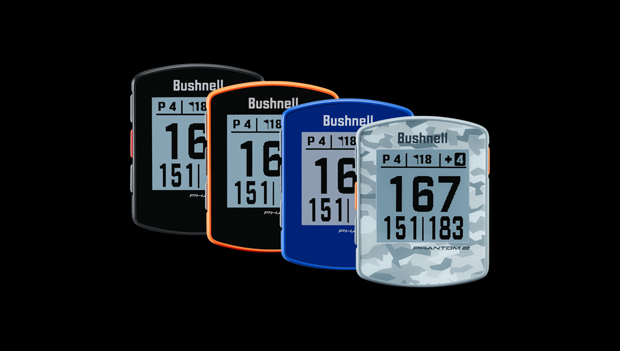
SPECS
- Accuracy: Within 3 yards of front and back of green yardages
- Slope: No
- Optics: 37mm x 37mm display screen
- Scan speed: GPS < 45 seconds TTFF (Typical Time to First Fix)
- Battery life: 18+ hours
The Phantom 2 GPS is remarkably straightforward, offering basic yardages for those who want quick ballpark numbers of how far away they are from the hole or different hazards. The unit attaches nicely to the cart and updates distance as you drive. While it doesn't offer exact hole location distances, there is a function where you can choose an approximate location on the green to get a yardage estimate. It's tough to get it spot on, but you will have a good idea of the distance.
Players looking for precision should stay in the laser category, but the Phantom 2 GPS is great for those looking for convenience and an inexpensive rangefinder option. The Bluetooth connectivity and over 18 hours of battery life are enticing parts of the device, as well.
What We Like
- Comes pre-loaded with over 38,000 courses
- Large, easy-to-read display screen
- Up to 6 hazard/layup distances per hole
- Greenview with movable pin placement
- Can play four rounds of golf on one charge
What We Don't Like
- No precise yardage to hole
- Accuracy is less precise than lasers
Best Bushnell GPS Watch - ION Edge
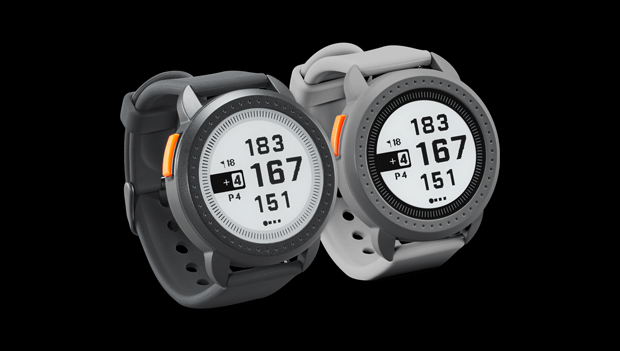
SPECS
- Accuracy: Within 3 yards of front and back of green yardages
- Slope: No
- Optics: 27.4 mm diameter display screen
- Scan Speed: GPS < 45 seconds TTFF (Typical Time to First Fix)
- Battery Life: 16+ hours
The ION Edge takes the same experience as the Phantom 2 GPS and puts it into a watch. This becomes incredibly convenient when you have to walk away from the golf cart for any reason, such as searching for a lost ball. Having yardages on your wrist at any point is definitely an advantage.
Accuracy is not quite as reliable given that exact hole locations can't be measured, but the ION Edge does have a few cool features. The watch automatically recognizes which course you are playing, and it can also report back about how far your previous shot traveled. It's an inexpensive option, and a simple one for those just looking for easy-to-access yardages.
What We Like
- Shot distance calculator
- Auto course recognition
- Convenience of having distance readings anywhere you go
- Waterproof
- Bluetooth compatibility
What We Don't Like
- Limited accuracy
- Less battery life than Phantom 2
Best Bushnell GPS Speaker - Wingman
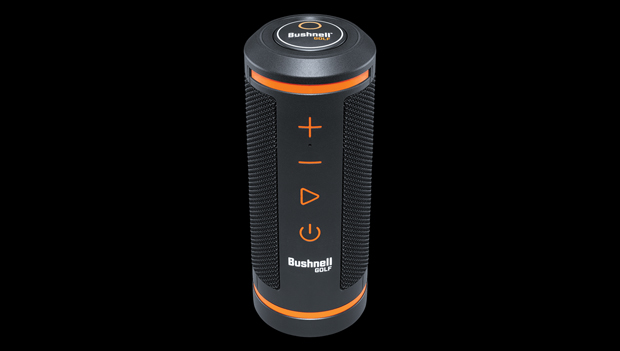
SPECS
- Accuracy: Within 3 yards of front and back of green yardages
- Slope: No
- Optics: Connects to Bushnell app on phone
- Scan speed: GPS < 45 seconds TTFF (Typical Time to First Fix)
- Battery life: Up to 10 hours
The Bushnell Wingman is essentially a smart golf speaker that can read golfers yardages while also playing music at a high quality. It's an ideal device for large groups playing together with a relaxed vibe while also still caring about having the proper yardages.
The device connects through the Bushnell app, so the yardages are the same as you would get in the Phantom 2 and ION Edge. The most noticeable part of the Wingman is that it clips on beautifully to the cart despite being larger than the other GPS rangefinders. It looks and sounds great, although this is definitely technology you only want to use while riding in a cart. The weight of the unit (24 ounces) is probably too much for most walkers to handle.
What We Like
- Simple attachment to cart
- High-quality speaker for music
- Easy GPS readings
- Direct connection to Bushnell app
What We Don't Like
- Limited Bluetooth range
- Hard to use when walking
What to Consider When Purchasing a Bushnell Rangefinder
Type
For most people searching through Bushnell rangefinders, the type is going to be a top priority. A more traditional rangefinder is handheld, allowing golfers to look through a lens to laser the target and find the correct yardage. These laser devices are allowed to be used in many competitions, and you will see some top players relying on them. One comforting aspect is that you can laser not only the flag but any target you want to get an immediate answer for distances. This is an old-school technique, but accurate laser devices never go out of style. While their one main drawback is that obstacles like trees or large mounds can prevent the laser from measuring distance, it's extraordinarily helpful on the vast majority of golf shots.
For those who want distance information without going through the effort of lasering each yardage, a GPS rangefinder can provide the distance to multiple targets or hazards at the same time. These rangefinders will update automatically as you move around the course, so you will always have a detailed sense of how far you are from the hole. You can attach a GPS rangefinder on your cart so that yardages are constantly updating. It's less effort, although you could also argue that it's less precise in terms of getting a distance to the exact pin location. A GPS rangefinder can account for almost everything except, in most cases, for where the hole is placed on the green. For that, a laser rangefinder can get a number.
A rangefinder type that is becoming increasingly popular is the watch rangefinder. This allows players to get GPS data delivered right to their wrist, so they are always one glance away from knowing the right distance. This enables golfers to walk away from the cart without having to worry about any rangefinder in their hand. It's also far easier to keep track of if it's on your wrist.
And finally, there are GPS speakers that carry visual information into auditory form by announcing distances. It's another way to become more efficient as a golfer. The speakers can also play music and serve as an entertainment center of sorts while you play, so this option can be great for someone who wants the information of rangefinder yardages while also playing the role of D.J. out on the course.
Accuracy
All golfers have certain distances that they hit each club. Knowing which club to select is a major part of the game's strategy. The only way to select properly is to know exactly what distance remains between you and your target. Many times that is the flag itself, but it can also be about knowing where obstacles are so you take steps to avoid them.
The only way to go through that process with confidence is to have an accurate yardage. Even if a rangefinder is off by just a handful of yards, that small gap can be the difference in carrying a bunker or finding yourself stuck in the sand. Having an accurate rangefinder gives you the best chance at having success. Certain rangefinders can read accurate yardages for targets well off in the distance, which can help a golfer strategize easier.
While all Bushnell rangefinders promise reliable accuracy, lasers are typically more precise. Also, the amount of information within them can be different. For instance, many rangefinders offer slope or environment data, which takes into account factors like elevation, temperature, or wind. An uphill shot may read 190 yards even if the total distance is just 180 yards. Those features can add other layers of accuracy to tell golfers how their surroundings are going to affect the shot ahead.
Optics
Golf is a game of visualization, so having a rangefinder with clear and captivating vision is undoubtedly necessary. This is also where a rangefinder's maximum distance comes into play, as rangefinders have different limits for how far away they can measure targets.
In a laser rangefinder, that comes down to the crispness of the magnified image and ability for the device to easily lock onto the target rather than hitting an object in the distance. It's worth noting that many golfers will use a laser rangefinder after they hit to see exactly where their ball finished, so a vivid picture is more than helpful.
With GPS and watch rangefinders, the optics come down to the simplicity of the visuals on the screen. There should be no doubt as to where the target is or how each distance provided corresponds with different landmarks on a hole. This is maybe even more important with watches because of the reduced screen size.
Scan Speed
It sounds like a small attribute, but a slow scan speed can make a rangefinder utterly unusable.
Scan speed refers to the time in between when golfers press scan to hit their distance and when the actual yardage appears. A rangefinder will often buzz to "lock in" to the flagstick just prior to the distance being given.
This process needs to happen quickly, especially if you are playing in competition. Hitting the scan button and waiting too long for a yardage to appear becomes a cumbersome process, so a fast scan speed is an important variable. Fortunately, the Bushnell laser rangefinders are all fast-acting, and the GPS units work properly after taking a short amount of time to recognize the course.
FAQs About Bushnell Rangefinders
Is a Bushnell rangefinder worth it?
Once you start using a Bushnell rangefinder on the course, it's difficult to imagine not having access to the technology. The device can accurately measure distances so you don't have to go trudging around looking for a sprinkler head to find a yardage. There is no brand more synonymous with distance measuring than Bushnell has been in golf the past few decades.
It's tough to play golf if you don't know how far to hit the ball. Having trustworthy information is what makes the game so enjoyable because you are able to honestly test yourself with each swing.
How long do Bushnell rangefinders last?
A Bushnell rangefinder usually lasts about 3-7 years depending on how often it is used. A properly maintained rangefinder that is stored away from harsh conditions might be able to extend its life further, but new technology often comes along to replace it. Many users may switch their type of rangefinder during that span, as well.
The top reason for a rangefinder losing steam is general wear and tear over time. If you clean the case, replace batteries when necessary, and avoid having it bake in the sun, a Bushnell rangefinder can run smoothly for many years.
Do I need slope on my rangefinder?
Not everyone needs or wants to have slope on their rangefinder, but it can be a big benefit for those who are interested. Using a slope function is typically outlawed in competitive play and even some casual golfers prefer not to use it because the slope function takes the guesswork out of knowing how differently a shot will play depending on elevation.
However, there should be zero shame in wanting to use the slope function. Golf is a difficult game, and we will take any help we can get. The slope function gets right to the point with identifying proper club selection, so golfers can get a great deal of use out of it.


